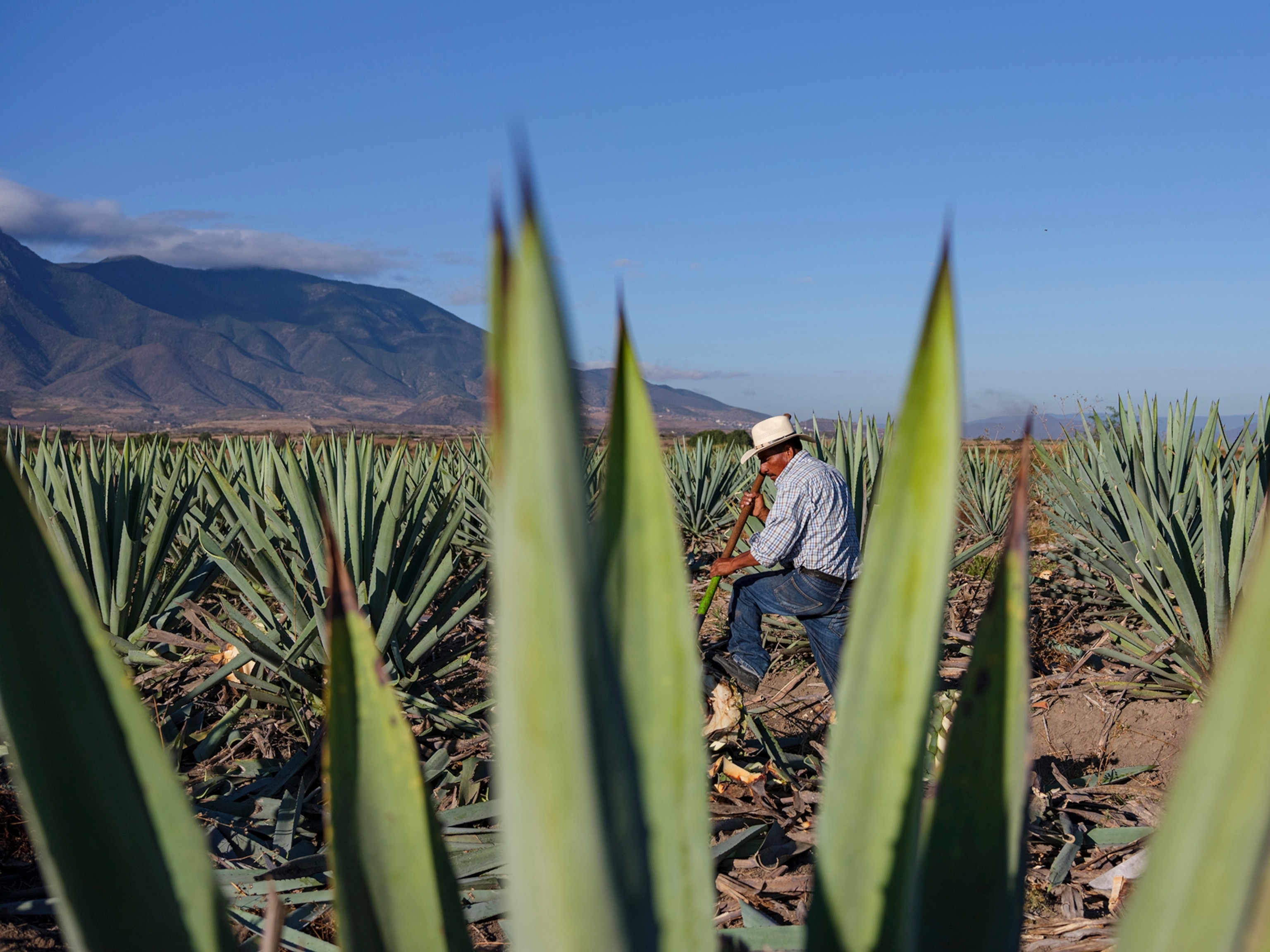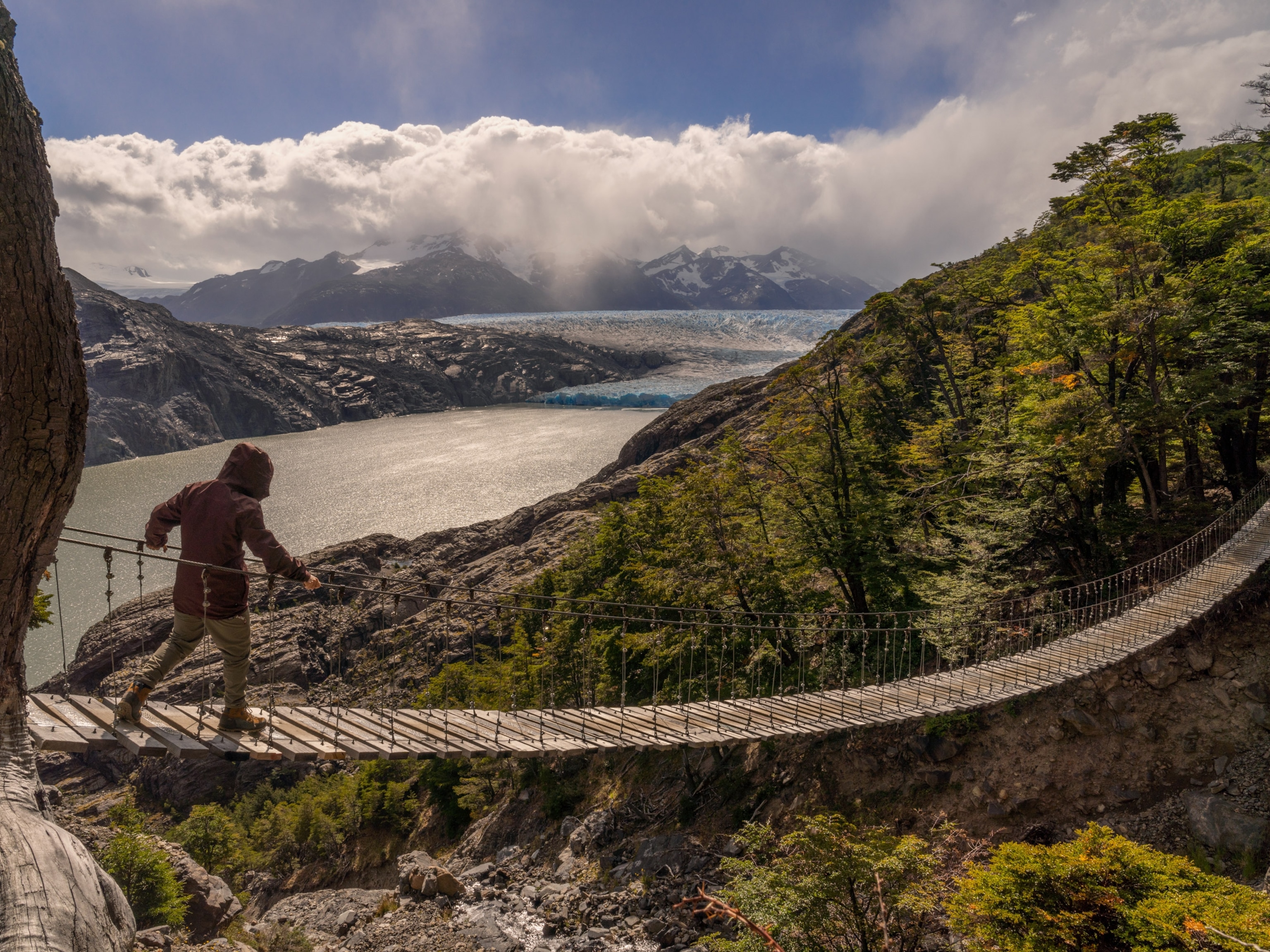Get Up Close With Wildlife in Mexico's Magdalena Bay
Want an authentic, animal-packed Baja experience? Head to this Pacific Ocean bay.
Cancún’s up there somewhere. But we never make it.
Our SUV is bouncing along the dirt moguls of a dark road. With dusk over and the sky blackening, we pass the outlines of cardon cacti under a smear of stars. Wiry palo adán shrubs, also called Adam’s trees, brush against our doors. Rising and falling, the headlights make the road to Cancún look like a gargantuan skeleton on a seafloor.
Wait. Not that Cancún.
This is the other side of Mexico from the famous Caribbean resort area. I’m in a lonely stretch of Baja California, heading toward the tiny fishing village of Puerto Cancún on Magdalena Bay in the Pacific, about four hours’ drive north of Cabo San Lucas. No one else is out here. Cell phone coverage stopped about three hours back. It’s a thrilling entry. But I feel a sense of doom, too.
I’m supposed to see gray whales out here. And wherever I try—Maine, Iceland—I fail. Maybe I’m cursed?
Camping in Baja
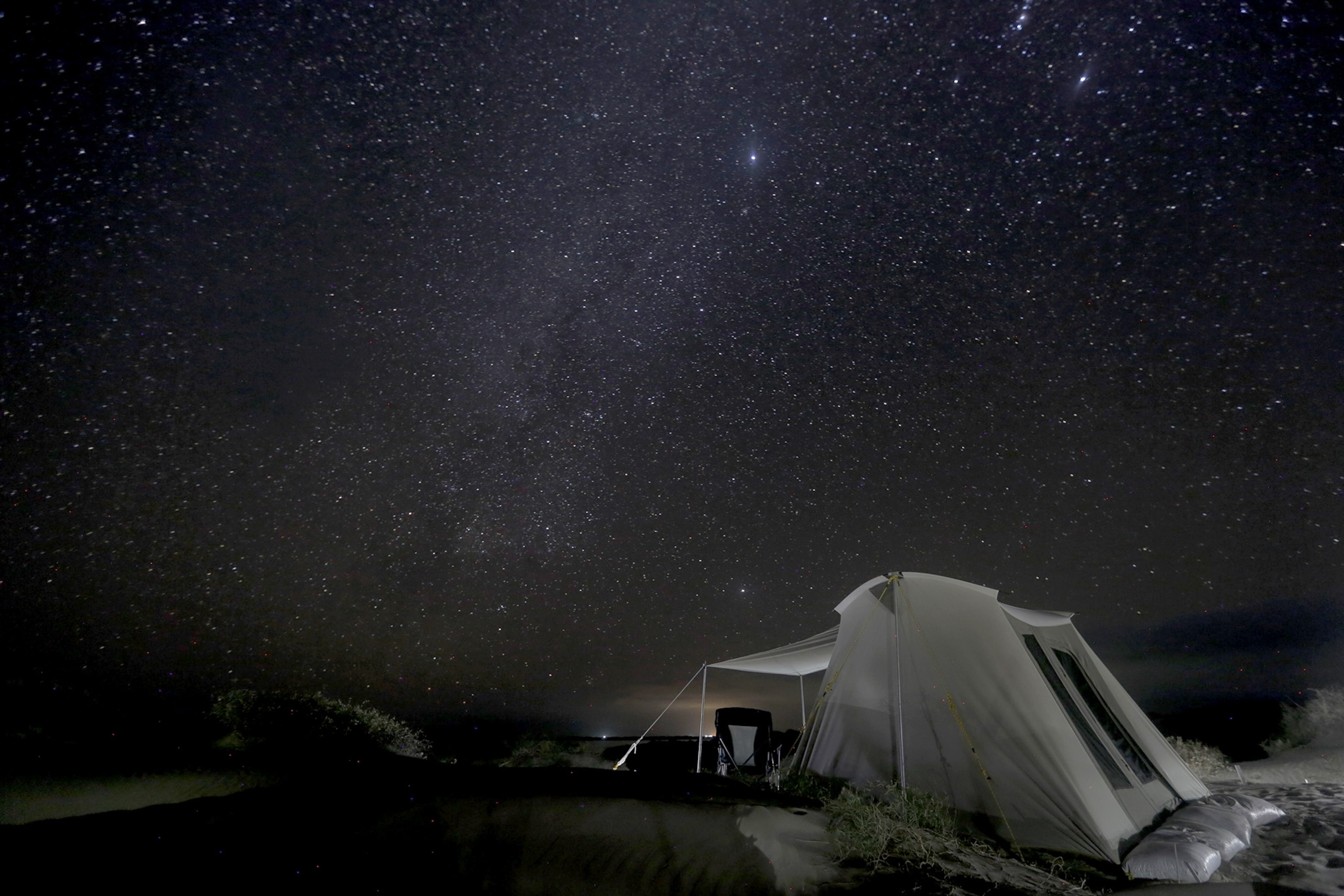
We finally turn onto a narrower side road, bypassing Puerto Cancún, and reach a waiting panga fishing boat. I wrap up in a fleece jacket as we ride out on the water under starlight. Flying mullet fish (called lisa here) jump alongside as we go. Ahead, I see a glow: white tents lit on the inside.
This is my destination for a couple of days: an eco-camp run by RED Travel with solar-powered lights lining walkways, open-air toilets facing dunes, a full kitchen (and margarita happy hour), a shower tent with hot water, and cozy tents with cots. It’s marvelous.
“Be sure to keep your shoes in the tents,” warns my guide, Andrea Adame Fernandez. “Coyotes sometimes play with them.”
Flipping open my tent door in the morning, I see tall dunes surrounding us and blue water beyond. In the dining tent, an old guitar hangs on a string next to a table library of charts and books on local marine life. Dressed in an orange chef’s outfit, Huber serves a hefty breakfast of chilaquiles with eggs, green sauce, tortillas, beans, and a pot of coffee. Huber grew up in Puerto Alcatraz, a nearby fishing village. Before cooking, he was a turtle poacher. Many locals enjoy turtle meat, he says, particularly during Semana Santa (Holy Week).
“After I started monitoring turtles, it became hard to fish for them,” he says. “My friends joke about having a turtle taco now. It’s like how meat eaters tease vegetarians.”
Searching for Sea Turtles
Sea turtles are abundant in Magdalena Bay—but so is poaching. Nearly 20 years ago two Americans founded an organization called Grupo Tortuguero to monitor the sea turtle population and promote local conservation efforts. (RED Travel helps fund its efforts.)
Soon we’re out on the bay to meet some turtles.
Despite a hundred or so attempts to colonize it, 30-mile-long Magdalena Bay remains very remote. Today there are only a couple of modest fishing towns to the north and smaller villages that live off generator power a few hours a day. Freshwater is scarce. So few visitors make it out here that it’s tempting to claim nothing much has changed.
On the water this morning, it’s so calm I can’t tell where the silky surface of the blue bay meets the sky ahead. “Keep your safari eyes open,” Andrea says, after a sea turtle pops up. “You never know what’ll appear.”
Supporting Turtle Conservation
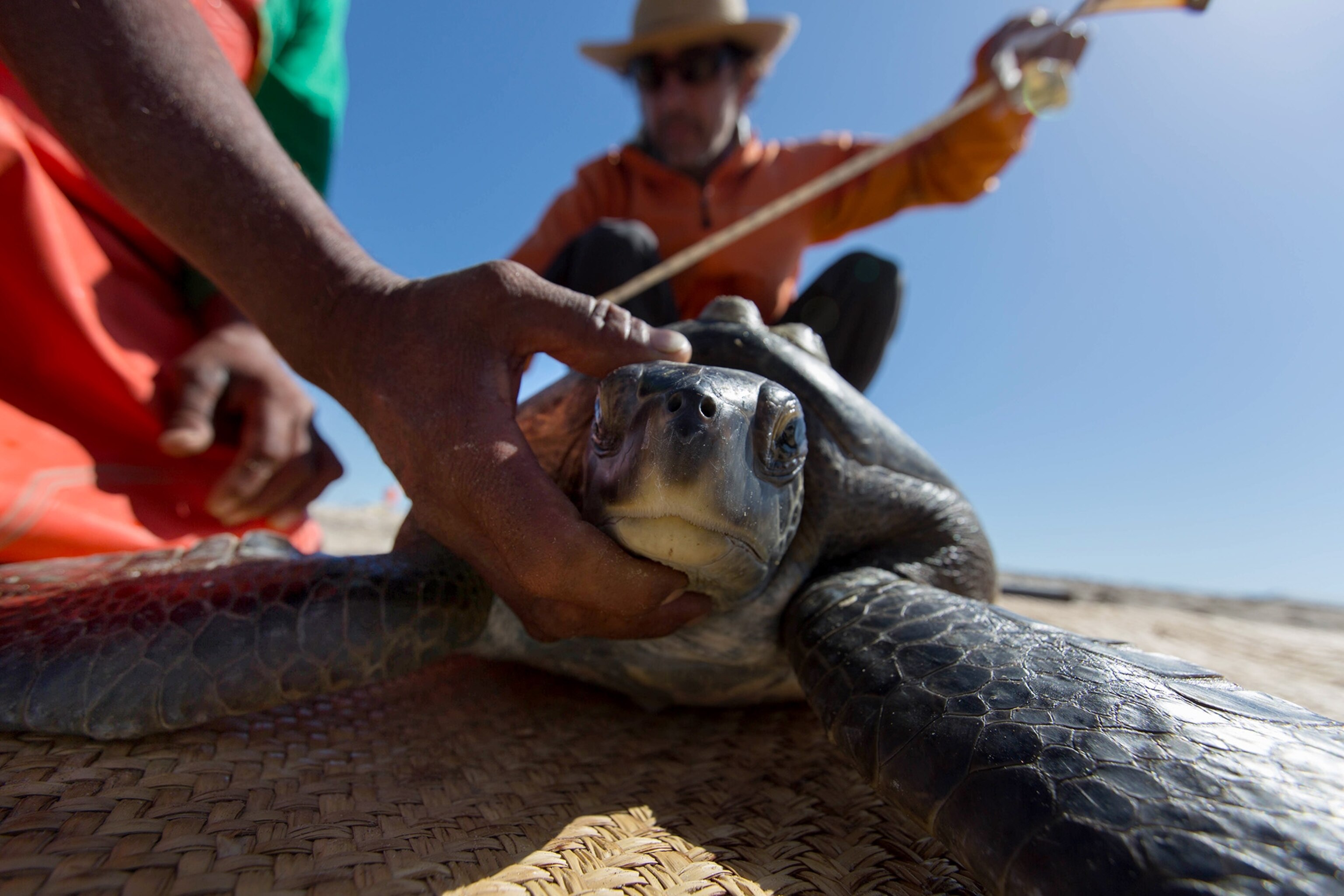
After an hour’s ride, we see two men standing in a small boat. We pull alongside to see their catch: a half dozen sea turtles to monitor. They use a specially designed net that, unlike fishing nets, allows captured turtles to rise for air. We follow the boat to a bare stone beach jutting out into the bay.
José, a local who’s worked with Grupo Tortuguero for seven years, barely moves his lips below a salt-and-pepper moustache when he speaks. “Years ago, people would sell turtles like watermelons,” he says. “Turtle poaching is never going to end. Humans are so hard to change.”
The goal is to curb the numbers.
Over the next hour, National Geographic videographer Spencer Millsap and I help with the turtles. We measure each one’s girth, body length, tail length, and weight. José tags them for future records. Some turtles resist, some “chill,” as José says. “Others like to be stroked.” Everything is recorded in detail, including a name for each turtle.
When I’m asked to offer a name for a feisty, healthy 35-year-old female, I write in “Ruby Reid” (after my eight-year-old daughter). Then we let her go. She scurries across the stone beach into the blue water, and with a flipper fury, swims off out of sight. The monitoring done for the day, we have a beach lunch of fresh burritos and Modelo beer. Sure beats Taco Bueno back in Oklahoma.
Spotting Baja's Gray Whales
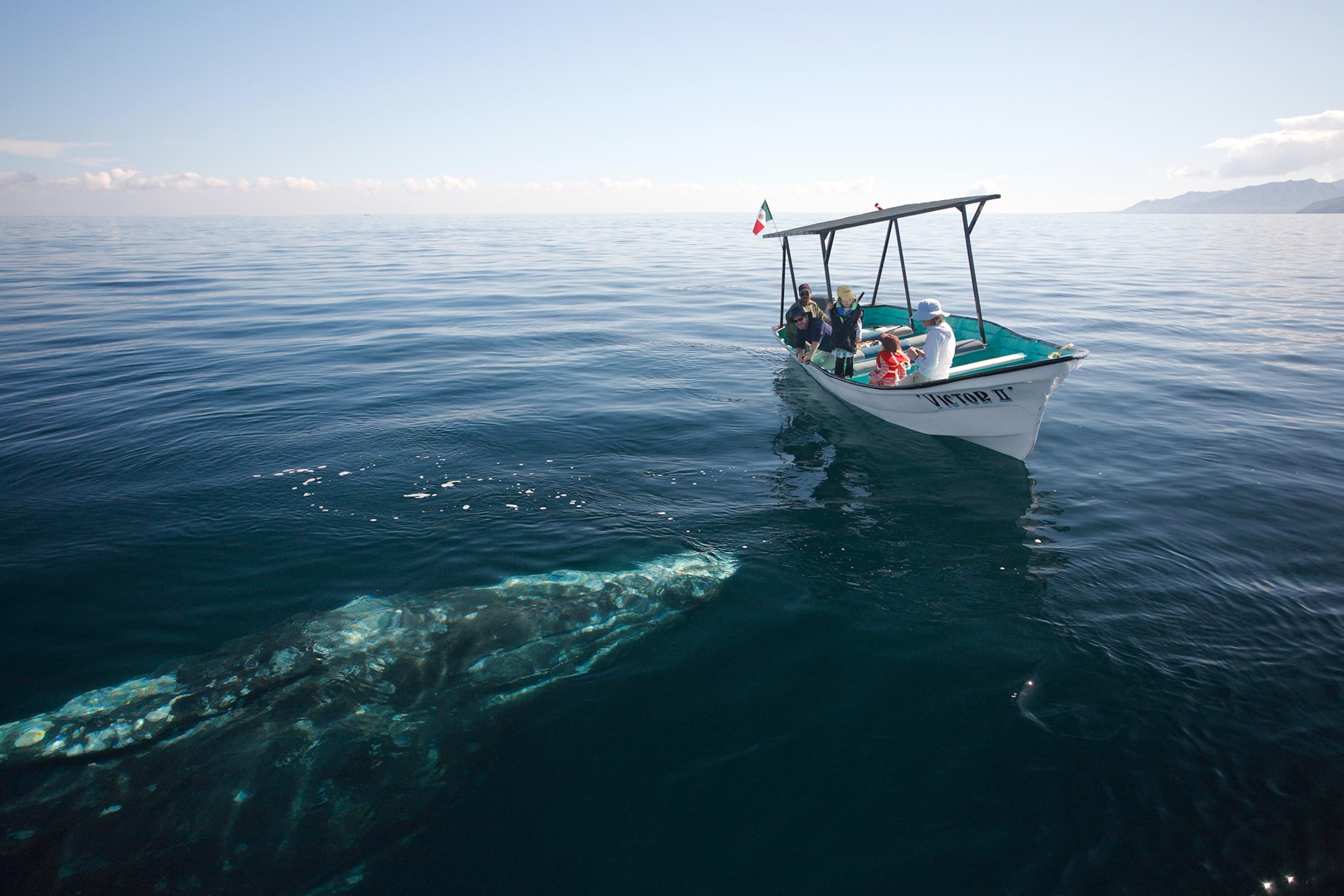
Next are the whales.
After an hour ride, the boat enters the narrow boca (mouth) at the bay’s south end. Frigate birds and pelicans watch us from the beach as we set up between the mainland mangroves and the orangey-brown, wrinkled peaks of long Isla Santa Margarita. Ahead I can see the crests of the Pacific’s stronger waves.
And then we’re surrounded.
Perhaps dozens of gray whales are around us. Some breach above the surface for air or to make a playful splash; others send up a gusty spray as they exhale and inhale through their double blowholes. Best are those that pop their heads slowly out vertically for a look around. This is called spyhopping. They have horrible eyesight, which only proves whales have a dry sense of humor, I think.
“I think they’re very happy animals,” says Andrea, who once worked at a dive shop in the Seychelles and joined her sister in La Paz from Tampico on the Gulf of Mexico last fall.
Isla Santa Margarita and Isla Magdalena protect Magdalena Bay from harsher Pacific winds, giving it a calm environment that encourages such rich marine life. For gray whales, which can grow to 35 tons and over 50 feet long, it’s a perfect playground. They travel south from Alaska in the fall, arriving in Mexico to spend the winter, give birth, and mate. About a year later they return to do it again.
- National Geographic Expeditions
Yep, that means most gray whales are Mexicans.
I’m asking Andrea about this when a spray suddenly appears directly next to us, and another. A trio of whales are right on us. And they want to play.
Before I can ask if whales bite through boats, one spins, or logrolls, as it comes alongside us. It must be twice as long as we are. I see its giant eye looking below the surface as it passes, and barnacles that pockmark its leathery skin. Another whale appears, sending a spray over us. Carlos, our driver, turns away and closes his eyes and mouth.
I reach out into the water and touch the whale’s skin. It’s softer than I expect. Behind us a tail flipper juts out of the water, accidentally bumping into the side of the boat. Then we surge forward a foot. One is underneath us, upside down, rubbing its belly against us.
Carlos has seen this most of his life. He was born “on km 157 on the highway” but “prefers the sea.” And when I catch his wide grin at this encounter, I realize being with whales will never get old. And at Magdalena Bay, it seems you’d have to be cursed not to see them.
I’m glad to learn I’m not.
How to Do This Trip
Some people book whale-watching trips from Puerto San Carlos or Puerto López Mateos, but you’re better off joining a tour.
La Paz–based RED Travel has eight tents in the secluded southern end of the bay near the boca. The camp season runs from December through March. Activities include turtle monitoring, whale spotting, climbing dunes, and visiting fishing villages.
Another Magdalena option is Pelagic Life, a group that does heroic work by offering an alternative to shark fishing: deep-sea dives with sharks and big fish. See their breathtaking film Mexico Pelagico on Netflix.




